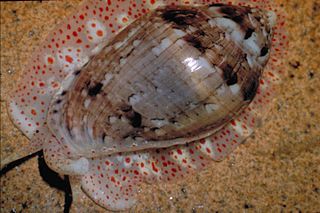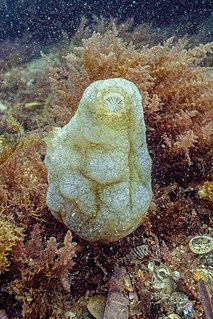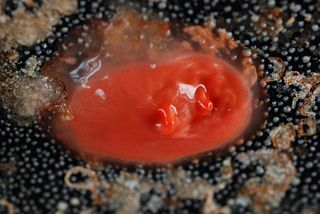
Marine biology is the scientific study of the biology of marine life, organisms in the sea. Given that in biology many phyla, families and genera have some species that live in the sea and others that live on land, marine biology classifies species based on the environment rather than on taxonomy.

Isopoda is an order of crustaceans that includes woodlice and their relatives. Isopods live in the sea, in fresh water, or on land. All have rigid, segmented exoskeletons, two pairs of antennae, seven pairs of jointed limbs on the thorax, and five pairs of branching appendages on the abdomen that are used in respiration. Females brood their young in a pouch under their thorax.

Marginella is a very large genus of small tropical and temperate sea snails, marine gastropod molluscs in the subfamily Marginellinae of the family Marginellidae, the margin snails. It is the type genus of the family.

In biology, a test is the hard shell of some spherical marine animals, notably sea urchins and microorganisms such as testate foraminiferans, radiolarians, and testate amoebae. The term is also applied to the covering of scale insects. The related Latin term testa is used for the hard seed coat of plant seeds.

The white-chinned thistletail or "colicardo barbiblanco" is a species of bird in the family Furnariidae. It is found in Colombia, Ecuador, Peru, and Venezuela. Its natural habitats are subtropical or tropical moist montane forests and subtropical or tropical high-altitude grassland.

Ascidiidae is a family of tunicates in the class Ascidiacea.

Phlebobranchia is a suborder of sea squirts in the class Ascidiacea.

Corallimorpharia is an order of marine cnidarians closely related to stony or reef building corals (Scleractinia). They occur in both temperate and tropical climates, although they are mostly tropical. Temperate forms tend to be very robust, with wide and long columns, whereas tropical forms tend to have very short columns with a wide oral disc and very short tentacles. The tentacles are usually arranged in rows radiating from the mouth. Many species occur together in large groups, although there are recorded instances of individuals. In many respects, they resemble the stony corals, except for the absence of a stony skeleton. Morphological and molecular evidence suggests that they are very closely related to stony corals.

Machairophora is a genus of moths in the subfamily Arctiinae first described by George Hampson in 1893. Two species are included, which are found from Sri Lanka and Papua New Guinea only.
The World Register of Marine Species (WoRMS) is a taxonomic database that aims to provide an authoritative and comprehensive list of names of marine organisms.

Freshwater snails are gastropod mollusks which live in fresh water. There are many different families. They are found throughout the world in various habitats, ranging from ephemeral pools to the largest lakes, and from small seeps and springs to major rivers. The great majority of freshwater gastropods have a shell, with very few exceptions. Some groups of snails that live in freshwater respire using gills, whereas other groups need to reach the surface to breathe air. In addition, some are amphibious and have both gills and a lung. Most feed on algae, but many are detritivores and some are filter feeders.

Glabella is a genus of small tropical and warm-water sea snails, marine gastropod molluscs in the family Marginellidae, the margin snails.

Phallusia is a genus of tunicates of the family ascidians, which includes the following species:

Phallusia nigra is a solitary marine tunicate of the ascidian class found in tropical seas around the world. It usually lives in shallow waters, attached to any hard substrate.
Louis Roule was a French zoologist born in Marseille.
Cuiciuna is a genus of longhorn beetles of the subfamily Lamiinae, containing the following species:
Cuiciuna fumigata is a species of beetle in the family Cerambycidae. It was described by Ernst Friedrich Germar in 1824. It is known from Brazil.
Capnogryllacris is a genus of leaf-rolling crickets in the subfamily Gryllacridinae and tribe Capnogryllacridini. Species are found in Far East and South Asia.
Phytoecia flavescens is a species of beetle in the family Cerambycidae. It was described by Brullé in 1833, originally under the genus Saperda. It is known from Macedonia and Greece. It contains the varietas Phytoecia flavescens var. fumigata.

Cnemidocarpa finmarkiensis is a species of solitary ascidian tunicate in the family Styelidae. Common names include broad base sea squirt, orange sea squirt, red sea squirt, shiny orange sea squirt, shiny red tunicate and Finmark's tunicate. It is native to shallow waters in the northern and northeastern Pacific Ocean.














